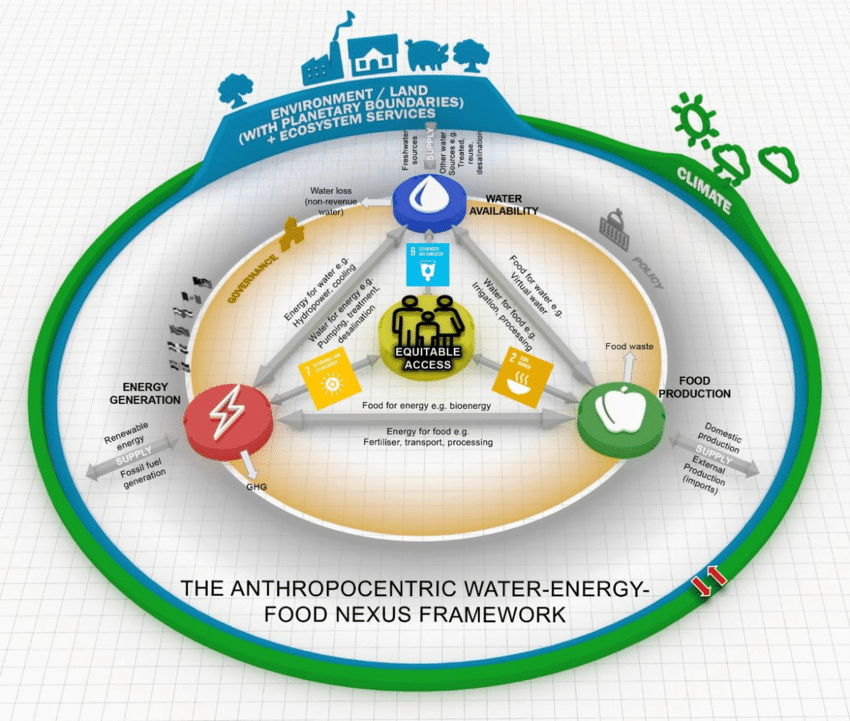Today, energy and sustainability are not separate concepts; they are two sides of the same coin. Our access to reliable energy sources underpins our economic growth, social development, and overall well-being. However, the way we produce and consume energy can have a significant impact on the environment, threatening the very foundation of this well-being.
This intricate relationship between energy and sustainability forms what’s known as the “energy-sustainability nexus.”
Understanding the Nexus
The energy-sustainability nexus highlights the critical interdependence between:
- Energy Security: Ensuring access to reliable and affordable energy sources is crucial for powering homes, businesses, and industries. However, factors like geopolitical instability, resource depletion, and climate change can threaten this security.
- Environmental Sustainability: The way we generate energy has environmental consequences. Burning fossil fuels releases greenhouse gasses that contribute to climate change, while other methods, like hydropower dams, can disrupt ecosystems.
- Social Development: Energy access is essential for improving living standards and providing opportunities for education and healthcare. Lack of access can hinder development and exacerbate poverty.
These three pillars of the energy-sustainability nexus are constantly interacting. For instance, increasing energy demand due to economic growth can put pressure on resources, leading to environmental concerns. Conversely, environmental degradation can threaten energy security by disrupting existing infrastructure or limiting access to resources.
Challenges and Opportunities
The energy-sustainability nexus presents us with a complex set of challenges:
- Balancing Demand and Supply: Meeting the growing global energy demand while transitioning away from fossil fuels requires innovative solutions and investments in clean energy technologies.
- Climate Change Mitigation: Reducing greenhouse gas emissions from the energy sector is crucial for mitigating climate change and its devastating consequences.
- Ensuring Energy Equity: Ensuring access to clean and affordable energy for all, particularly in developing nations, is essential for achieving sustainable development goals.
However, amidst these challenges lie significant opportunities:
- Renewable Energy Revolution: The rapid advancement of renewable energy sources like solar, wind, and geothermal offers a path toward a sustainable energy future.
- Energy Efficiency: Promoting energy-efficient technologies and practices can significantly reduce energy consumption without compromising economic growth.
- Decentralised Energy Systems: Investing in decentralised energy solutions like rooftop solar panels or microgrids can enhance energy security and reduce dependence on traditional fossil fuel infrastructure.
Moving Towards a Sustainable Energy Future
Addressing the energy-sustainability nexus requires a multi-pronged approach involving:
- Policy and Regulation: Governments can implement policies that incentivise renewable energy development, energy efficiency measures, and carbon capture technologies.
- Technological Innovation: Continued research and development in clean energy technologies are essential for achieving significant reductions in greenhouse gas emissions.
- Public Awareness and Education: Raising public awareness about the importance of energy conservation and sustainability can empower individuals to make informed choices.
- International Cooperation: Global collaboration is crucial for facilitating knowledge sharing, technology transfer, and financial support for developing nations transitioning to clean energy.
Examples of the Nexus in Action
Here are some real-world examples that illustrate the energy-sustainability nexus:
- Biofuel Production: While biofuels can offer a renewable alternative to fossil fuels, their production can compete with food security and lead to deforestation. Finding a sustainable balance is essential.
- Hydropower Dams: Hydropower is a clean energy source, but dams can disrupt ecosystems and displace communities. Careful planning and responsible dam management are crucial.
- Smart Grids: Smart grids can optimise energy distribution, reduce energy waste, and integrate more renewable energy sources into the power grid. This technology offers a win-win for both energy security and sustainability.
A Sustainable Future is Possible
The energy-sustainability nexus presents a complex challenge, but it also offers a roadmap for a brighter future. By acknowledging the interconnectedness of energy and sustainability, we can chart a course towards a clean energy future that ensures economic prosperity, social development, and a healthy planet for generations to come. Embracing innovation, fostering collaboration, and making conscious choices can help us navigate the energy-sustainability nexus and turn the challenges into opportunities for a more sustainable world.
